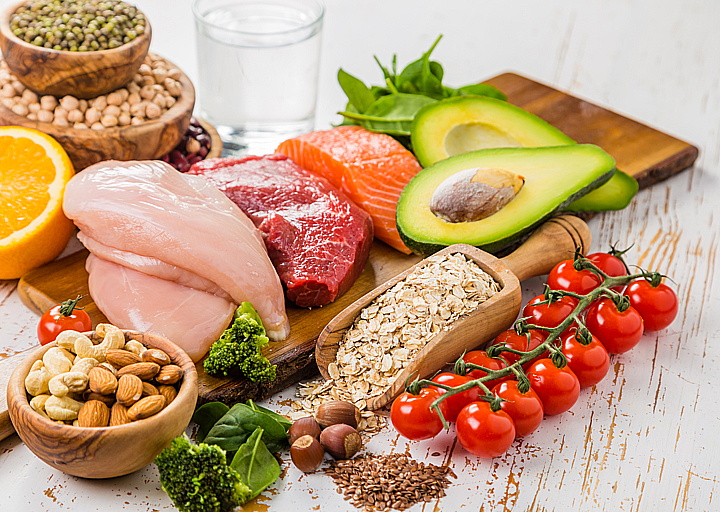Vitamin B5, or pantothenic acid, is water-soluble and is essential to all forms of life. In the diet, the principle active form of pantothenic acid is Co-enzyme A (CoA). Upon ingestion, dietary CoA turns into pantothenic acid in readiness for intestinal absorption. Following absorption into cells, pantothenic acid gets converted back into CoA, which is vital to a multitude of biochemical reactions that sustain life.
Food Acupuncture: Vitamins & Minerals
Small but significant: Tiny amounts big results Structuring/building/connecting/energizing/repairing/healing…
The power of vitamins comes from the power of real food
Vitamin B5 is water soluble
Present in many foods, pantothenic acid is also produced by bacteria in the colon and as a result dietary deficiency is rare.
Sources of vitamin B5
Vitamin B5 is well represented in a wide range of foods. The list includes egg yolk, animal organs such as liver and kidney, chicken, beef, fish, shellfish, pork, milk, milk products, tomatoes, legumes, mushrooms, avocados, broccoli, cereal grains, sweet potatoes, seeds—especially sunflower seeds—and spinach.
Different foods vary in their vitamin B5 content; for example, 85g of beef liver, or fish (trout) provide 5.6 mg and 2.0mg of B5 respectively. Half a cup of lentils, peas or mushrooms will provide 0.63, 0.58, and 0.52 mg of B5 respectively, whilst half an avocado contains 1.0 mg of vitamin B5.


Whole grains are good sources of B5, but processing and refining grains may result in a 35–75% reduction of vitamin B5 available for absorption. Freezing and canning foods result in similar losses.
Pantothenic acid is also produced by bacteria in the colon. However, while the bacteria that normally colonize the colon can synthesize pantothenic acid and a few studies have suggested that we may be able to absorb pantothenic acid produced by these intestinal bacteria, the extent to which they contribute to satisfying our pantothenic acid needs is yet unquantified.
Functions:
Like other vitamins, vitamin B5 is multifunctional. It known as the "centre of energy", helping to convert food into energy. Without pantothenic acid we really cannot process any vital nutrients into energy. CoA plays an important role in both the making and the degradation of many molecules and is crucial for the Human body to properly process carbohydrates, amino acids, proteins, vitamins A and D, as well as in the regulation of many hormones. It also helps to make lipids (fats), cholesterol, neurotransmitters, steroid hormones, haemoglobin and is important for healthy skin. The metabolism of a number of drugs and toxins is facilitated by CoA in the liver.
![]()
Vitamin B5 deficiency:
A varied diet provides enough vitamin B5 for most people. B5 deficiency is very rare in humans and has been noted only in cases of severe malnutrition, as a result of famine or war. During World War II prisoners of war in the Far East, in the Philippines, Burma, and Japan, experienced numbness, painful "burning" sensations and tingling in their feet, symptoms which were relieved by B5 supplementation.
Urinary excretion below 1 mg per day generally indicates low dietary intake.
Supplements:
Vitamin B5 is commercially available under names such as pantothenic acid, panthenol, calcium pantothenate and dexapanthenol among others. People take pantothenic acid as a supplement to prevent and treat dietary deficiencies. In adults, taking 5-10 mg of pantothenic acid daily by mouth prevents and treats pantothenic acid deficiency.
Pantothenic acid is frequently used in combination with other B vitamins as vitamin B complex.
Most multivitamin/mineral supplements provide at least 5 mg/day of pantothenic acid. Supplements mainly contain panthenol, a synthetic form of pantothenic acid. In some jurisdictions pantethine is used as a cholesterol-lowering agent.
Toxicity:
Vitamin B5 from food as well as supplements is safe for most people when taken by mouth in appropriate amounts. The recommended dose for adults is 5 mg daily. With larger amounts—up to 10 grams—seemingly safe for some people. Between 10–20 g/day will increase the occurrence of side effects such as diarrhoea.
A life-threatening clinical outcome has been reported in the case of an elderly woman who took a combination of 10 mg/day of biotin and 300 mg/day of pantothenic acid for two months.
Pantethine—a form of pantothenic acid—is generally well tolerated in doses of up to 1,200 mg/day.
Gastrointestinal side effects, such as nausea and heartburn, have been reported above this level of intake. Excess B5 is normally excreted by the kidneys.
Drug interactions:
Oral contraceptives—birth control pills—containing estrogen and progestin may increase the requirement for pantothenic acid. Use of pantethine in addition to cholesterol-lowering drugs (statins) can result in an increased reduction of blood lipid levels by producing a combined effect. Large doses of pantothenic acid have the potential to compete with biotin (vitamin B7) for intestinal and cellular uptake.
Special precautions and warnings:
Pregnancy and breast feeding:
Taking recommended amounts of 6 mg of pantothenic acid orally daily during pregnancy and 7 mg per day during breast-feeding is likely safe. However, it is not known if taking more than this amount is safe. One should generally avoid ingesting greater amounts of pantothenic acid.
Older adults (>50 years):
There is currently little evidence to suggest that older adults’ pantothenic acid intakes or requirements differ from those of younger people.
Return to the list of B vitamins.



